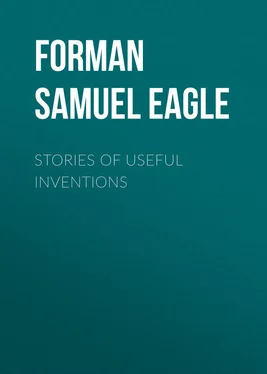Samuel Forman - Stories of Useful Inventions
Здесь есть возможность читать онлайн «Samuel Forman - Stories of Useful Inventions» — ознакомительный отрывок электронной книги совершенно бесплатно, а после прочтения отрывка купить полную версию. В некоторых случаях можно слушать аудио, скачать через торрент в формате fb2 и присутствует краткое содержание. Жанр: foreign_antique, foreign_prose, на английском языке. Описание произведения, (предисловие) а так же отзывы посетителей доступны на портале библиотеки ЛибКат.
- Название:Stories of Useful Inventions
- Автор:
- Жанр:
- Год:неизвестен
- ISBN:нет данных
- Рейтинг книги:5 / 5. Голосов: 1
-
Избранное:Добавить в избранное
- Отзывы:
-
Ваша оценка:
- 100
- 1
- 2
- 3
- 4
- 5
Stories of Useful Inventions: краткое содержание, описание и аннотация
Предлагаем к чтению аннотацию, описание, краткое содержание или предисловие (зависит от того, что написал сам автор книги «Stories of Useful Inventions»). Если вы не нашли необходимую информацию о книге — напишите в комментариях, мы постараемся отыскать её.
Stories of Useful Inventions — читать онлайн ознакомительный отрывок
Ниже представлен текст книги, разбитый по страницам. Система сохранения места последней прочитанной страницы, позволяет с удобством читать онлайн бесплатно книгу «Stories of Useful Inventions», без необходимости каждый раз заново искать на чём Вы остановились. Поставьте закладку, и сможете в любой момент перейти на страницу, на которой закончили чтение.
Интервал:
Закладка:
A metal that was so useful was needed in large quantities, yet the primitive forge could turn out only small quantities of iron. A day's labor at the bellows would produce a lump weighing only fifteen or twenty pounds. As a result of this slowness in manufacture there was always in primitive and ancient times a scarcity of iron. Indeed in some countries iron was a precious metal, almost as precious as silver or gold. In many countries, it is true, there were thousands of forges at work, but in no country was the supply of iron equal to the demand. The old forge could not supply the demand, yet centuries passed before any great improvement was made in the progress of iron making.
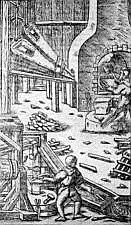
FIG. 6. – A BLAST FURNACE OF THE MIDDLE AGES.
Near the close of the Middle Ages improvements upon the primitive forge began to be made. In the sixteenth century ironmakers in Germany began to smelt ore in closed furnaces and to build their furnaces higher and to make them larger (Fig. 6). Sometimes they built their furnaces to a height of twenty or thirty feet. About this time also a better and a stronger blast was invented. Water-power instead of hand-power began to be used for operating the bellows. In some cases wooden bellows – great wooden pistons working in tubs – were substituted for the old bellows of leather. By the end of the sixteenth century so many improvements had been made upon the primitive forge that it no longer resembled the forge of ancient times. So the new forge received a new name and was called a blast furnace . 10 10 The old forge continued to be used by the side of the blast furnace for centuries, and of course where it was used it was still called a forge. Thus we are told that in Maryland in 1761, there were eight furnaces and ten forges. It is said that as late as twenty-five years ago in certain parts of the Appalachian regions the American mountaineer still worked the little primitive forge to make his iron.
You should observe, however, that the blast furnace was simply the old forge built with a large closed furnace and provided with a more powerful blast.
The invention of the blast furnace marked the beginning of a new era in the history of iron making. In the first place there was produced in the blast furnace a kind of iron that was entirely different from that which was produced in the primitive forge. In the primitive forge there was made a lump of practically pure unmelted iron, known as wrought iron. In the blast furnace there was produced a somewhat impure grade of melted iron, known as cast iron, or pig 11 11 It was given the name of pig iron because when the molten metal ran into the impressions made for it upon the sanded floor and cooled, it assumed a shape resembling a family of little pigs.
iron. In the second place, the blast furnace produced iron in quantities vastly greater than it was ever produced by the old forge. In the blast furnace more iron could be made in a day than could be made by the forge in a month. In some of the early blast furnaces a thousand pounds of iron could be made at one melting and we read of one early furnace that produced 150 tons of iron in a year.
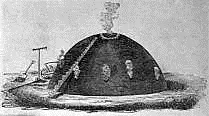
FIG. 7. – MAKING CHARCOAL.
But even with the blast furnace it was still difficult to make enough iron to supply the ever-increasing demands of the industrial world. In the sixteenth and seventeenth centuries machinery was brought into use more than ever before and of course more iron was needed for the construction of the machines. There was ore enough for all the iron that was needed but it was difficult to get fuel enough to smelt the ore. Charcoal was still used as the fuel for smelting (Fig. 7), and in order to get wood for the charcoal great inroads were made upon the forests. In England in the early part of the eighteenth century Parliament had to put a check upon the manufacture of iron in certain counties in order to save the forests of those counties from utter destruction. It then became plain that if iron making were to be continued on a large scale a new kind of fuel would have to be used in the furnaces. So men set their wits to work to find a new kind of fuel. As far back as 1619 Dud Dudley in the county of Warwick, England, undertook to use ordinary soft coal in his furnaces but his experiment was not very successful or very profitable. More than a century after this an English ironmaker named Abraham Darby began (in 1735) to use charred coal in his blast furnaces, and his experiments were successful. Here was the new fuel which was so badly needed. Charred coal is simply coke and coke could be had in abundance. So the new fuel was soon used in all parts of England and by the end of the eighteenth century coke was driving charcoal out of blast furnaces (Fig. 8).
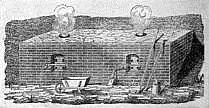
FIG. 8. – A PITTSBURGH COKE OVEN.

FIG. 9. – A MODERN BLAST FURNACE.
About the time the use of coke for smelting became general, an Englishman named Neilson brought about another great change in the process of iron making. Before Neilson's time the blast driven into the furnace had always been one of cold air. Neilson learned that if the air before entering the furnace were heated to a temperature of 600 degrees it would melt twice the amount of ore and thus produce twice the amount of iron without any increase in the amount of fuel. So he invented (in 1828) a hot blast for the blast furnace (Fig. 9). With the use of coke and with the hot blast the production of iron increased enormously. But there was need for all the iron that could be made. Indeed it seems that the world can never get too much iron. About the time the hot blast was invented iron chains instead of ropes began to be used for holding anchors, iron plows began to be made in great numbers (p. 83), iron pipes instead of hollow wooden logs began to be used as water-mains in cities, and iron rails began to be used on railroads. To supply iron for all these purposes kept ironmakers busy enough, even though they burned coke in their furnaces and made use of the hot air blast.
But ironmakers were soon to become busier than ever before. About the middle of the nineteenth century Sir Henry Bessemer invented a new process of making steel. Steel is only iron mixed with a small amount of carbon. Ironmakers have known how to make steel – and good steel, too – for thousands of years, but before the days of Bessemer the process had always been slow and tedious, and the cost of steel had always been very great. Bessemer undertook to make steel in large quantities and at low prices. In his experiments amid showers of molten metal he often risked his life, but his perseverance and courage were rewarded. By 1858 he had invented a process by which tons of molten iron could be run into a furnace and in a few minutes be converted into a fine quality of steel. This invention of Bessemer was the last great step in the history of the forge.
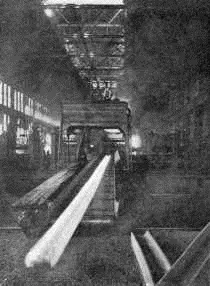
From copyright stereograph by Underwood & Underwood, N. Y.
FIG. 10. – GREAT STEEL RAIL PASSING THROUGH ROLLER STEEL MILL.
Читать дальшеИнтервал:
Закладка:
Похожие книги на «Stories of Useful Inventions»
Представляем Вашему вниманию похожие книги на «Stories of Useful Inventions» списком для выбора. Мы отобрали схожую по названию и смыслу литературу в надежде предоставить читателям больше вариантов отыскать новые, интересные, ещё непрочитанные произведения.
Обсуждение, отзывы о книге «Stories of Useful Inventions» и просто собственные мнения читателей. Оставьте ваши комментарии, напишите, что Вы думаете о произведении, его смысле или главных героях. Укажите что конкретно понравилось, а что нет, и почему Вы так считаете.
